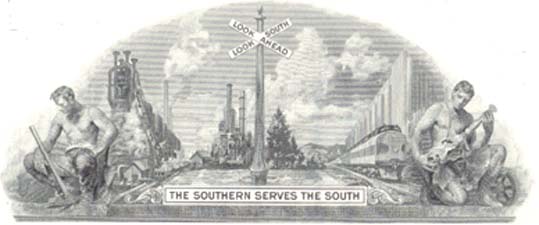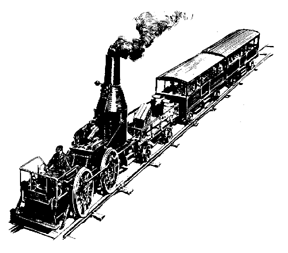

![]()
The Southern Railway was an innovator in the railroad business. Among their firsts, were complete dieselization, use of computers, modern hump yard design, and innovative freight car design (all door boxcars and the Big John and Super Big John aluminum covered hoppers and many others).
One of the predecessors of the Southern was the South Carolina Canal and Rail Road Co. This company was established by the legislature on December 19, 1827. The charter of this company was to build a railroad from Charleston to Hamburg, Columbia, and Camden, and a canal between the Savannah River and the Ashley River. Stock was sold in early 1828, and a survey was commissioned. In mid 1829, Horatio Allen was hired as the chief engineer. Construction of the 149.5 mile route began in Charleston on January 9, 1830. Most of the early track was built on pilings, with flat bars used as rail on top of the wood pilings, except for the curves, where flanged rails (more expensive) were used. The first locomotive was ordered in the summer of 1830 from the West Point Foundry in New York City, and arrived in Charleston on October 23 1830. This locomotive was named the "Best Friend of Charleston."

Two excellent references on the Best Friend!
A good article, from NS World, on the man who drove Souhtern's replica for 14 years!
Test runs took place from November 2 until mid December. On Christmas Day in 1830 the "Best Friend of Charleston" stamped its name on the dusty pages of history by becoming the first steam locomotive to pull a train of: cars in regular service on this continent. It made its initial run on the first completed six miles of the South Carolina Canal and Rail Road Company track.
But six months later, on June 17, 1831, the "Best Friend" exploded when a workman tied down a safety valve on the boiler to shut off the loudly hissing steam. With the running parts salvaged from the wreck, a new locomotive was built and named "Phoenix," after the bird in Egyptian legend which, consumed by fire, rose in youthful freshness from its own ashes. The Phoenix emerged as the in October 1832.
By October, 1833, the South Carolina Canal and Rail Road Company opened to its entire length - 136 miles from the port city of Charleston to the town of Hamburg, across the Savannah River from Augusta, Ga. At the time the pioneer railroad gained another niche in history-it was the world's longest railway. For 11 years afterward the railway operated under its contradictory name (the company originally contemplated dredging a canal to be operated in connection with its proposed "Rail Road" but the plan was dropped before anything was ever done about it). Then, in early 1844, the SCC&RR merged with the Louisville, Cincinnati and Charleston Railroad Company and the two adopted the name South Carolina Railroad Company. Tickets for travel on the South Carolina Railroad Company at this time were just like money.
The Civil War left the road physically wrecked and financially shaky. That, plus, unwise and overzealous postwar expansion plans drove its owners into bankruptcy. In 1881 the South Carolina Railroad Company was reorganized with a slight change in name as the South Carolina Railway Company. Under this ownership it continued to expand until it included all of what is now the Southern Railway's present Piedmont division except the line from Camden, S. C., to Marion, N. C., which the Southern acquired in 1889.
In 1894 the South Carolina Railway became the South Carolina and Georgia Railroad Company, but it, too, defaulted on its obligations. The Southern Railway Company acquired control of the SC&G in 1899, and in 1902, a lease was executed between the two railways giving the Southern the right to operate the South Carolina & Georgia Railroad Company for 999 years from July 1, 1902. The lease, still in effect, expires in the year 2901 A.D.
The Southern Railway Company began life on July 1, 1894 when the Richmond and Danville RR System and the East Tennessee, Virginia & Georgia RR were consolidated. The Southern continued to grow by lease and acquisition. I put together a family tree on the Southern. This family tree has been created as an image map, and contains over 120 companies that made up the Southern Railway. The family tree is as complete as the data in my personal library and information that I have found on the web. Some of this information is contained in the Manuscript Sources for Railroad History Research in the Special Collections Department of the University Libraries at Virginia Tech which some of the companies are linked to.
By the late 1970's, Southern was a large system, in other words, a large collection of companies. These companies were both rail and non-rail related businesses. At the end of 1978 Southern operated 10,248 miles of track, and had over 1500 locomotives on its roster and was continually purchasing new equipment to keep up with its customer's needs. Norfolk Southern developed a brief history of the Southern Railway.
The Southern Railway continued to grow via acquisitions. In 1982, the Southern merged with Norfolk & Western, and the name of the resulting company, was named after the Norfolk Southern Railroad. The Norfolk Southern has been acquired by the Southern in 1974.